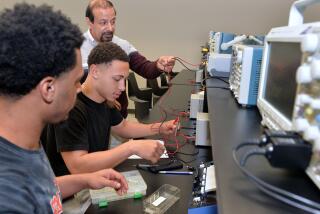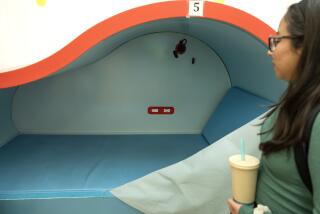College Education Online: Pass? Fail?
Gone are the days when students had to attend classes on campus to earn a college degree.
With the most distant university and the most obscure facts a mouse click away, students are finding they can get a college education via computer. Nearly 2 million U.S. students take courses online, in an approach often called distance learning.
âExpanding technology is expanding the audience for traditional educators,â said William H. Dutton, a technology and communications professor at USC. âTechnology only complements and supplements university instruction. For many, itâs just another place to get information.â
But the growth has led to a debate on California campuses and across the country over the future of high-tech study. Will technological study aids, from crib notes posted on the Internet to online degree programs, enhance education? Or will âe-educationâ supplant bricks-and-mortar classrooms and perhaps degrade the quality of learning and instruction?
The American Federation of Teachers published a report last month saying some programs âmay inhibit rather than promote good education.â
The report condemns the high-tech programs for âdehumanizingâ the learning experience.
Being in a classroom, soaking up enthusiasm for a subject by interacting face to face with instructors and peers is quite different from tapping in online, critics say.
âItâs the difference between just calling your mother on the phone and going to visit her,â said Martin Hittelman, a Los Angeles Valley College math instructor and senior vice president of the California Federation of Teachers.
Beyond questioning the quality of distance education, critics say it is too susceptible to fraud and can devalue a college degree.
John Bear, an educational consultant and author of a guide to online programs, speaks ambivalently about them, saying they can be abused by crafty students padding their resumes with ill-gotten degrees and unscrupulous companies operating fake universities to fleece earnest students.
âItâs a marvel that education is available anywhere for the disabled, the blind, the poor, the working mom with two full-time jobs who canât get away to go to class,â Bear said. âToo many other people are using technology for fraud and exploitation.â
In a survey to detect fraudulent degrees, Bear said he discovered nine NASA employees, several U.S. military officers and a safety engineer at Bridgestone/Firestone Inc. with fake degrees. He said he found thousands more on job search Web site Monster.com.
Ethical questions aside, the convenience of online education is hard to beat.
The tech-savvy student can sign up for a distance learning program--the Internet version of correspondence courses--to earn bachelorâs, doctoral and postdoctoral degrees and never come face to face with a professor.
Cal State Dominguez Hills graduate student Catherine French-Sidotiâs job, for example, puts her out of reach of a university campus. A quality assurance engineer at the Los Alamos nuclear weapons lab in New Mexico, French-Sidoti chose the online program over an educational sabbatical.
After logging on for registration, she ordered textbooks from Amazon.com, turned in homework assignments by e-mail and deliberated with classmates in Web discussion groups. For finals, a co-worker stood in as proctor, making sure she finished in the given time and did not cheat.
âI would have had to drive 90 miles to Albuquerque to go to class,â French-Sidoti said. âThe advantage [of taking classes online] is I can do my work during lunchtime or on Sundays or any other time thatâs convenient to me.â
The number of students in online classes doubled from 753,000 to 1.6 million from 1995 to 1998, according to the National Center for Education Statistics. A bill in the House of Representatives would allow 10 universities and colleges to offer financial aid to distance learners in a pilot program sponsored by the Education Department.
A study by the California Postsecondary Education Commission, released in August, showed that more than two-thirds of online students in the state are women, suggesting the off-campus option suits working mothers. Not surprisingly, private companies are looking for ways to profit from the multibillion-dollar movement. Yahoo, the Webâs most popular portal, launched a site last month where students and educators may post class rosters, calendars and syllabi and meet on private classroom message boards. Yahoo has partnered with content providers Bartleby.com, Britannica.com and Houghton Mifflin Co. for the enterprise.
Software developer Sherry Albright of Macola, Ohio, saw a barrage of layoffs in her field and figured she needed to complete her bachelorâs degree to stay competitive. It would take a two-hour drive after work to attend Ohio State University in Columbus, which would keep her from her teenage children, she said.
Instead, she logged on to the distance program offered by Ohioâs Franklin University, where professors set their schedules to chat online with students each week.
French-Sidoti and Albright acknowledge that they may be missing social interaction with their peers, but Warren Ashley, director of the Center for Mediated Instruction and Distance Learning at Cal State Dominguez Hills, said the idea that students gather around to sit and talk is a myth.
âIn reality, 65% of them come after 4 oâclock, park, walk to their classes and leave without much contact with their classmates,â he said.
Hittelman contends that at its best, online learning still has less depth than a part-time on-campus education.
âA lot of education is modeling, feeling something from the person providing it,â Hittelman said. âYou get more of the essence of a subject from talking about it than you do from just reading about it. We want to make sure people have a rich education, like a good meal, instead of a connect-the-dots education, like just take a pill for nourishment.â
Online study aids--even if students attend classes--can cheapen the educational experience as well, critics say.
Students too young to remember Atari know that term papers and lecture notes are readily available on the Web. Cliffs Notes, the yellow-and-black saviors of many a procrastinator, have gone digital. Cliffs will even send a free daily e-mail on understanding Shakespeare, called âDummies Daily.â
âDistance education and technology will spawn a whole new industry of people getting paid to do other studentsâ work,â said educational technology professor M.O. Thirunarayanan of Florida International University.
Some students agree digital courses are no substitute for the real thing.
Kenneth Autrey, a masterâs degree candidate in the distance learning program at the University of Phoenix, began his graduate studies at Cal State Dominguez Hills before transferring to Phoenix.
âWith all the online resources--Cliffs Notes, term paper research help--it was much easier for me to return to college, but it is definitely not as thorough an educationâ as on the Cal State campus, Autrey said.
Massachusetts Institute of Technology received an $11-million grant in June to make lecture notes, course outlines, reading lists and assignments for its classes available free on the Web. Even so, an MIT administrator said students still clamor to attend the prestigious campus, where tuition is $27,000 a year.
âIf a person wants to just learn the material, I see no reason why they canât learn it on their own,â Bear said. âIf they want the prestige of a Wharton MBA or an MIT degree, they will still have to go to Wharton or MIT.â
More to Read
Sign up for Essential California
The most important California stories and recommendations in your inbox every morning.
You may occasionally receive promotional content from the Los Angeles Times.










